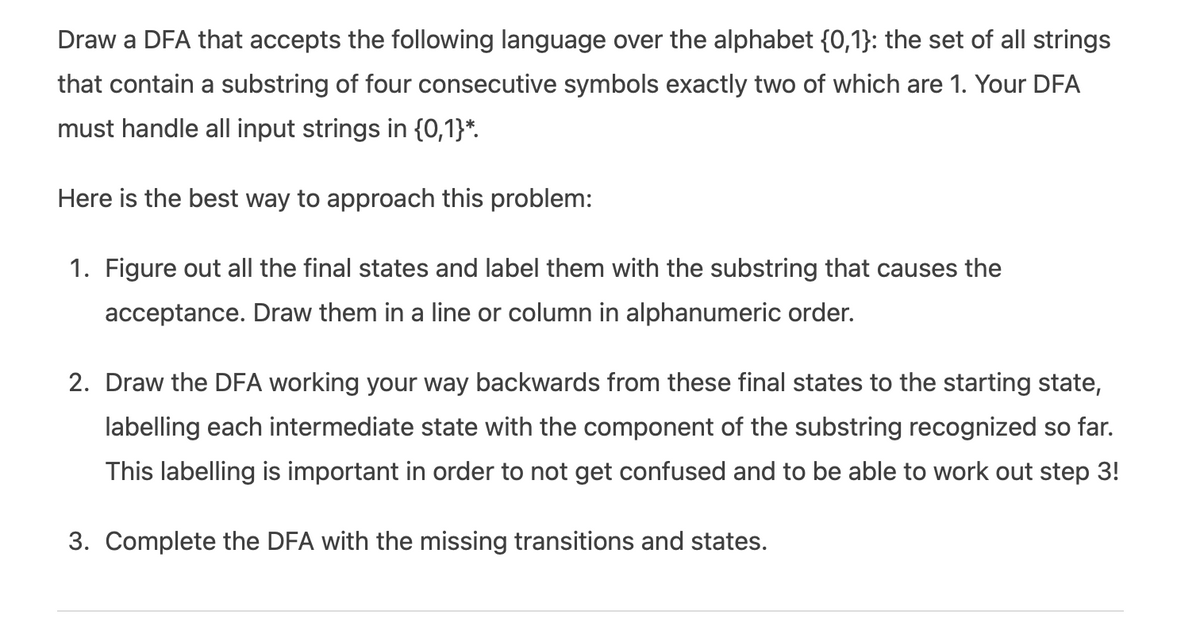Draw a DFA that accepts the following language over the alphabet {0,1}: the set of all strings that contain a substring of four consecutive symbols exactly two of which are 1. Your DFA must handle all input strings in {0,1}*. Here is the best way to approach this problem: 1. Figure out all the final states and label them with the substring that causes the acceptance. Draw them in a line or column in alphanumeric order.
Draw a DFA that accepts the following language over the alphabet {0,1}: the set of all strings that contain a substring of four consecutive symbols exactly two of which are 1. Your DFA must handle all input strings in {0,1}*. Here is the best way to approach this problem: 1. Figure out all the final states and label them with the substring that causes the acceptance. Draw them in a line or column in alphanumeric order.
Computer Networking: A Top-Down Approach (7th Edition)
7th Edition
ISBN:9780133594140
Author:James Kurose, Keith Ross
Publisher:James Kurose, Keith Ross
Chapter1: Computer Networks And The Internet
Section: Chapter Questions
Problem R1RQ: What is the difference between a host and an end system? List several different types of end...
Related questions
Question

Transcribed Image Text:Draw a DFA that accepts the following language over the alphabet {0,1}: the set of all strings
that contain a substring of four consecutive symbols exactly two of which are 1. Your DFA
must handle all input strings in {0,1}*.
Here is the best way to approach this problem:
1. Figure out all the final states and label them with the substring that causes the
acceptance. Draw them in a line or column in alphanumeric order.
2. Draw the DFA working your way backwards from these final states to the starting state,
labelling each intermediate state with the component of the substring recognized so far.
This labelling is important in order to not get confused and to be able to work out step 3!
3. Complete the DFA with the missing transitions and states.

Transcribed Image Text:Draw a DFA that accepts the following language over the alphabet {0,1}: the set of all strings
such that any substring of four consecutive symbols does not have exactly two Os.
(Hint: look at the solution of the previous question)
Expert Solution
This question has been solved!
Explore an expertly crafted, step-by-step solution for a thorough understanding of key concepts.
This is a popular solution!
Trending now
This is a popular solution!
Step by step
Solved in 2 steps with 2 images

Recommended textbooks for you

Computer Networking: A Top-Down Approach (7th Edi…
Computer Engineering
ISBN:
9780133594140
Author:
James Kurose, Keith Ross
Publisher:
PEARSON

Computer Organization and Design MIPS Edition, Fi…
Computer Engineering
ISBN:
9780124077263
Author:
David A. Patterson, John L. Hennessy
Publisher:
Elsevier Science

Network+ Guide to Networks (MindTap Course List)
Computer Engineering
ISBN:
9781337569330
Author:
Jill West, Tamara Dean, Jean Andrews
Publisher:
Cengage Learning

Computer Networking: A Top-Down Approach (7th Edi…
Computer Engineering
ISBN:
9780133594140
Author:
James Kurose, Keith Ross
Publisher:
PEARSON

Computer Organization and Design MIPS Edition, Fi…
Computer Engineering
ISBN:
9780124077263
Author:
David A. Patterson, John L. Hennessy
Publisher:
Elsevier Science

Network+ Guide to Networks (MindTap Course List)
Computer Engineering
ISBN:
9781337569330
Author:
Jill West, Tamara Dean, Jean Andrews
Publisher:
Cengage Learning

Concepts of Database Management
Computer Engineering
ISBN:
9781337093422
Author:
Joy L. Starks, Philip J. Pratt, Mary Z. Last
Publisher:
Cengage Learning

Prelude to Programming
Computer Engineering
ISBN:
9780133750423
Author:
VENIT, Stewart
Publisher:
Pearson Education

Sc Business Data Communications and Networking, T…
Computer Engineering
ISBN:
9781119368830
Author:
FITZGERALD
Publisher:
WILEY